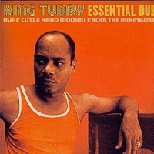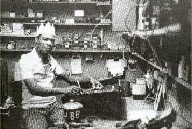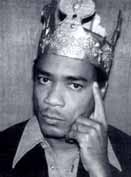Metro CD021 licenced from Trojan Records

Selected mixes 1973-76 by Osbourne
"King Tubby "Ruddock. Seventeen tracks by the Aggrovators, Augustus Pablo,
Tommy McCook, Horace Andy and others, co-production by Bunny Lee, Winston
"Niney "Holness and others.
The Flamingo Club, Soho, London 1964. My friend Vince is
setting up with his little semi-acoustic blues band, ready to roll out those
Muddy Waters covers. He's appearing opposite some Jamaican outfit called Duke
Reid's Sound System. They've taken over most of the stage.
We've never
seen such electrification. Stacked speaker cabs loom like monster upright
coffins, and West Indian guys in pork-pie hats and tonic suits keep bringing in
more gear. Only things missing are guitars, drum kit, horn cases. But they've
set up a huge turntable deck.
And then they start to play
records. With a strange throbbing back-to-front beat. Very, very loud. Is
that it...? Everybody's soon rocking but as middle-class blues purists, we are
deeply confused.
Club boss Rick Gunnell explains. "They just play
records. But they're special records...." We don't get it, even when
Vince doesn't get a return gig. We don't realise that we're witnessing the very
early stages of a seminal movement in popular music.
King Tubby
(1941-1989) wasn't fat. He earned the name through his expertise with tubes --
radio valves -- and his early mastery of circuitry, condensers, transformers,
equalisers - all the inner mysteries of audio engineering. After building
special high power amps for the early 60s Jamaican sound system men like Duke
Reid and Clement "Sir Coxsone" Dodd, it was a logical step to start cutting
acetate masters for the local Kingston record producers.
These prized
"dub plates" which gave privileged sound system operators a preview of the
latest potential hits, were recorded on two-track tape, usually with the vocal
on one channel and the backing track on the other. The B-side was usually the
instrumental version of the song, minus vocals - a recycling strategy developed
for economic rather than artistic reasons - and was often used as a music bed
for DJs and MCs to chat over.
Tubby began to experiment with special
"versions", dropping the vocals in and out, filtering the rhythm, or feeding
tracks through his own custom-built loop-echo and spring reverb units. When he
brought all the elements together in the late sixties in his own massive Home
Town Hi Fi sound system, with his DJ Edward "U Roy" Beckford toasting on the
microphone "the crowd did a quick double take and then went wild... knocking
the speaker boxes flying..." (Steve Barrow)

By the early seventies, Tubby had built his own tiny studio, with
a second-hand four channel mixer, customised to give smoother cross-fades and
tighter equalisation. His skill in mixing attracted the top producers, who'd
bring in their rhythms as raw material for his sonic re-sculpting. The reggae
industry was fiercely competitive, so it was a high-speed operation, with a
quick turnaround. Consequently Tubby executed most of his mixes in real-time,
live on the board. And every one was different.
This album is only a
tiny selection from the hundreds of tracks Tubby was involved in during his 70s
heyday. The house musicians aren"t listed but sax man Tommy McCook, organist
Ansel Collins, bassist Robbie Shakespeare and drummer Sly Dunbar were regular
members of the Aggrovators, playing on innumerable sessions. In the collective
sound-world of dub, individual horn or keyboard phrases float out into the
ether while massive bass figures emerge from the depths, offset against hissing
cymbals or subtly chopped guitar riffs.
 It's said
that Tubby never smoked ganja. But the whole dub experience could be heard as
an epiphany of Rastafarian psychedelia -or least as a virtual recreation of
listening to music while profoundly stoned... On one track, "A Better Version"
- based on Horace Andy's "Better Collie" (i.e better cannabis) wisps of the
vocal hang in the void over the cross-fire of reverbed guitar chords, rim-shots
, even gun shots.
It's said
that Tubby never smoked ganja. But the whole dub experience could be heard as
an epiphany of Rastafarian psychedelia -or least as a virtual recreation of
listening to music while profoundly stoned... On one track, "A Better Version"
- based on Horace Andy's "Better Collie" (i.e better cannabis) wisps of the
vocal hang in the void over the cross-fire of reverbed guitar chords, rim-shots
, even gun shots.
In "Conversation Dub" and "Psalm of Dub" there's
the same use of silences, bass and drum lines stripped down to the essence (and
of course, anticipating the bass'n' drum phenomenon by decades) . Even when
horns are featured on "Bongo Man Dub" the sax wails over echoing chunks of
guitar, while Augustus Pablo's melodica makes spectral noises over the spaces
of "Barbwire Disaster".
Perhaps the most prophetic track is "A
Rougher Version". Ian McCann , who wrote the excellent notes for this
compilation, claims that this is "techno twelve years ahead of schedule". Using
basic analogue technology -- no samplers, no digital delay -- Tub transforms
the song into a strange but wonderful soundscape, a dread elegy in acoustic
deep space. The mixing board itself has become a key creative part of the
ensemble, an instrument in its own right -- a development which is now central
to contemporary music production.
Of course the pioneer rock
producers (Tom Dowd, Spector, Sam Philips) and the electronic music vanguard
(Pierre Schaeffer, the BBC Radiophonics Workshop) had been exploring the
possibilities of the studio and the tape deck since the fifties. And by the
early seventies certain word-scientists in Victoria and Vancouver BC were
launching their own trips into acoustic space. After hearing some
DNA tapes at a Montreal
reading a dazed young woman asked Brother P how it felt to be "lost in the
caverns of your own voice." (Citizens, it felt good...)
But Tubby was
starting from scratch, devising his own technology, with few artistic
preconceptions, and working in a culture where rhythms and rhymes were part of
a communal oral culture, a sound matrix in which elements could be constantly
re-cycled and re-arranged. So, to quote
John
McCready " There is a good case to be made for dub as the genesis of remix
culture. The early hip hop block parties in New York manned by those such as
Kool Herc (a Jamaican by birth) and Grandmaster Flash are obviously derived
from the sound system scene in Kingston."
King Tubby, the Dub
Organiser, was mysteriously shot dead outside his home in Kingston in 1989. But
his influence, channeled through UK reggae masters like Dennis Bovell or Adrian
Sherwood, and reinforced by the availability of sophisticated digital
techniques, now seeps into trance techno, jungle, hip hop -- all the post-rock
dance music genres. David
Toop notes how "dub has become a sci-fi soundtrack for techno-Gaians,
hippie zippies and cyborg animists," who -- paradoxically? -- hear it as "a
humanistic healing force in a wired world."
High Town, Hereford,
England. June 2, 2002. It's Queen Windsor's Jubilee Mix'n' Melt Down so the
town has organised rain-swept festivities in the main precinct. We're here
because my son James is break-dancing with The Juice Crew, but we've also been
promised folk, swing, brass band - and dub. The Juice Crew slip and slide
through their routine to old hip hop tapes.
Then Dub Merge take the
stage -- a dude on turntables who looks like a young Haile Selassie, and two
white guys on mics. The rhythms echo round the market place. The tall crusty
blonde with the dreadlocks rants,rails at Babylon, the System, toasts his
Respect to the Herb, while his side-kick in a big hat riffs back responses .
The burghers of Hereford dance under their umbrellas, small children
jump up and down while on the periphery three nervous-looking young male
anarchists with fluffy chins start circling the precinct parading their black
banner BOLLOCKS TO THE MONARCHY. A neighbourhood cop stops them for a little
chat. The beat goes on.
The youth may diss Mrs Battenberg, but no
bollock the King, innit? Even here in this strange small green island, his
dread beats - slow, spacey, cunning - subtly shift the foundations...
© Paul A Green 6/2002